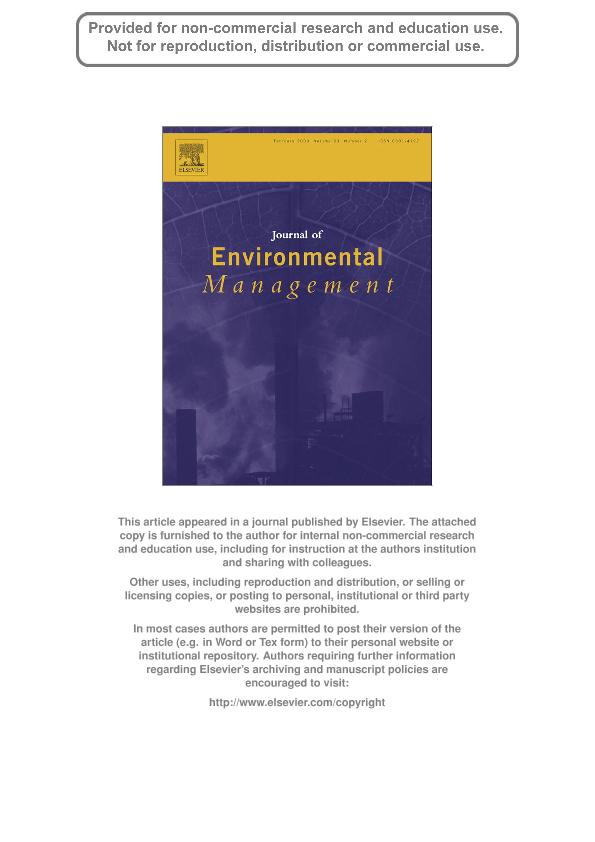Mostrar el registro sencillo del ítem
dc.contributor.author
Izquierdo, Andrea Elisa

dc.contributor.author
Grau, Hector Ricardo

dc.date.available
2019-05-16T14:00:39Z
dc.date.issued
2009-02
dc.identifier.citation
Izquierdo, Andrea Elisa; Grau, Hector Ricardo; Agriculture adjustment, land-use transition and protected areas in Northwestern Argentina; Academic Press Ltd - Elsevier Science Ltd; Journal of Environmental Management; 90; 2; 2-2009; 858-865
dc.identifier.issn
0301-4797
dc.identifier.uri
http://hdl.handle.net/11336/76535
dc.description.abstract
Land-use change is the main component of regional environmental change, while protected areas represent a direct land use policy to prevent its potentially negative effects on biodiversity and environmental services. We combined an analysis of trends in land use and human demography with trends in creation of protected areas during the last three decades in northwestern Argentina, a subtropical region including a wide range of environments. The eighty nine administrative analysis units of the region were classified into four ecological groups based on their percentage of cover by the six eco-regions of the study area: (1) "Dry valleys"; dominated by Middle-elevation deserts; (2) "Highlands", dominated by High-elevation alpine zones and plateaus; (3) "Humid ecosystems", dominated by Foggy grasslands and Humid forests, and (4) "Dry forests". Between 1970 and 2002, human population became concentrated in urban areas and land use trends varied greatly among the four ecological groups. Agricultural area decreased in the Highlands and increased in the other regions, particularly in the Dry forests. Domestic animals decreased in Humid ecosystems, Highlands and the Dry valleys; and remained constant in the Dry forests. Several protected areas were created, but most of them were established in regions undergoing a decreasing intensity of land use. Overall, the analysis shows that agricultural production is becoming concentrated in the areas more suitable for modern agriculture while marginal agriculture areas and, particularly, extensive grazing are decreasing. The creation of protected areas reflects the decreasing opportunity costs of marginal areas and is failing to protect the eco-regions most threatened by current land-use trends.
dc.format
application/pdf
dc.language.iso
eng
dc.publisher
Academic Press Ltd - Elsevier Science Ltd

dc.rights
info:eu-repo/semantics/openAccess
dc.rights.uri
https://creativecommons.org/licenses/by-nc-sa/2.5/ar/
dc.subject
ECO-REGIONS
dc.subject
ECOSYSTEMS RECOVERY
dc.subject
GAP ANALYSIS
dc.subject
LAND-USE CHANGE
dc.subject
LAND-USE TRANSITION
dc.subject.classification
Otras Ciencias Biológicas

dc.subject.classification
Ciencias Biológicas

dc.subject.classification
CIENCIAS NATURALES Y EXACTAS

dc.title
Agriculture adjustment, land-use transition and protected areas in Northwestern Argentina
dc.type
info:eu-repo/semantics/article
dc.type
info:ar-repo/semantics/artículo
dc.type
info:eu-repo/semantics/publishedVersion
dc.date.updated
2019-05-06T13:49:43Z
dc.journal.volume
90
dc.journal.number
2
dc.journal.pagination
858-865
dc.journal.pais
Estados Unidos

dc.description.fil
Fil: Izquierdo, Andrea Elisa. Consejo Nacional de Investigaciones Científicas y Técnicas. Centro Científico Tecnológico - Tucumán. Unidad Ejecutora Lillo; Argentina. Universidad Nacional de Tucumán. Facultad de Ciencias Naturales e Instituto Miguel Lillo. Instituto de Ecología Regional; Argentina
dc.description.fil
Fil: Grau, Hector Ricardo. Consejo Nacional de Investigaciones Científicas y Técnicas. Centro Científico Tecnológico - Tucumán. Unidad Ejecutora Lillo; Argentina. Universidad Nacional de Tucumán. Facultad de Ciencias Naturales e Instituto Miguel Lillo. Instituto de Ecología Regional; Argentina
dc.journal.title
Journal of Environmental Management

dc.relation.alternativeid
info:eu-repo/semantics/altIdentifier/doi/https://dx.doi.org/10.1016/j.jenvman.2008.02.013
dc.relation.alternativeid
info:eu-repo/semantics/altIdentifier/url/https://www.sciencedirect.com/science/article/pii/S0301479708000601
Archivos asociados
